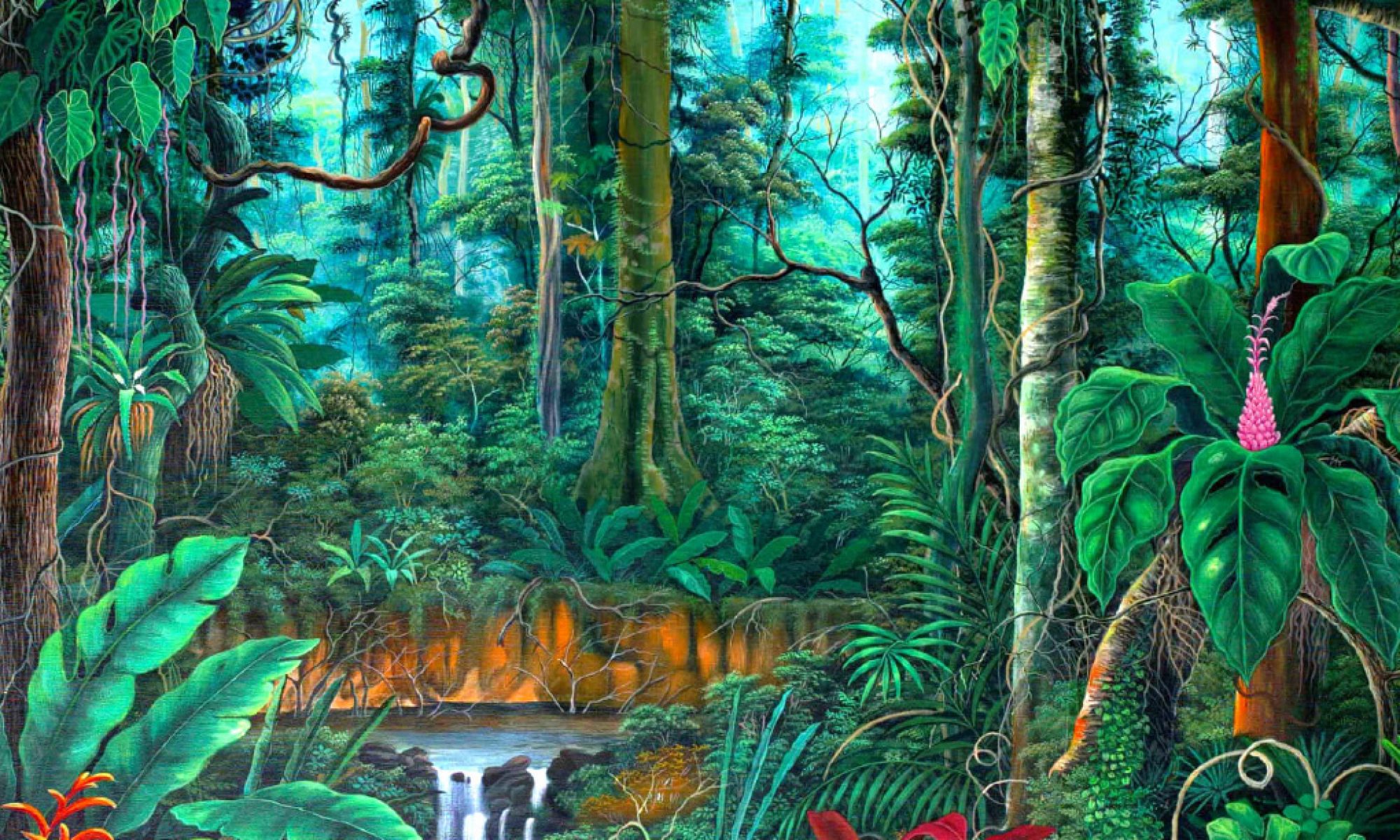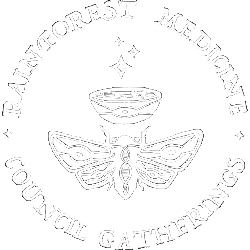In this article, I will share some key insights into the notable varieties of Amazonia’s enigmatic visionary vine, Banisteriopsis caapi, specifically related to the Indigenous science of yagé, as known and practiced by the Western Tukanoan speaking Siekopai people of the northern Ecuadorian Amazon. The information I received about these plants was imparted to me by the kind-hearted traditional elders, stewards of this ancestral sacred knowledge, whom I befriended during my sojourn of five years (1995-2000) while living at the home of traditional elder Cesáreo Piaguaje. A focus on the indigenous names of B. caapi in the Paicoca language reveals fascinating symbolic attributes and cultural lore related to this mystical woody liana that is the basis of the holistic, ceremonial, and entheogenic plant medicine tradition of yagé. While the B. caapi vine is today known globally as simply “ayahuasca”, a closer look at the Indigenous names and knowledge about B. caapi reveals a much more intricate, multiplex, and compound impression.
This region of northwestern South America, unsurpassed by any other in terms of its biological and cultural diversity, is where the vine of yagé came forth. In the peoples’ gardens where these plants are grown, they hold a special place as protagonists of the indigenous cosmology. The cultivation of food crops and medicinal entheogenic plants has, for centuries, facilitated the Siekopai to live felicitous lives in harmony with their wilderness homelands. The traditional families who have preserved these customs have done so precisely as a means to resist the woeful interruptions of colonialism.
Recently, there has been increasing discussion about the classification and effects of the different varieties of B. caapi. There is a phenomenon known among the Siekopai, and of this, there is much less talk about the yagé vine as a kind of “house,” where different qualities of spirits reside. The diverse varieties do indeed have distinct effects, which the elders consider to be produced by the yagémo’pai, the innate spirits of the yagé vine.
WHILE THESE YAGÉ SPIRITS CAN BE CHANNELED TO TEACH WONDERFUL THINGS AND TO HEAL, CONVERSELY, GIVEN THAT THEY ARE CONSIDERED TO BE SPIRITS BOUND BY TIME AND SPACE, THEY CAN ALSO KEEP PARTICIPANTS FROM BEING ABLE TO PERCEIVE THE CELESTIAL REALITIES, THAT ARE TRANSCENDENT OF TIME AND SPACE.
This explains why many shamans of old were experienced at “fishing out” these innate spirits in the yagé vine, a highly advanced spiritual skill!
While each variety may have a singular innate quality, traditional healers can also override a particular yagé’s characteristics. These “graduated drinkers”, disciplined individuals who have gone through great extremes to obtain wisdom and spiritual abilities, as the renowned yagé doctor Fernando Payaguaje would call them, used their ritual meditations to convoke specific types of celestial spirits, inviting them to reside inside the yagé vine. The tara’yagé variety is always used to house these matëmo’pai, the “heavenly people,” or “divine immortals,” which is why it is considered a mother, or source, vine. Furthermore, tara’yagé is the type of vine that most closely resembles a proto-variety, now lost, that was gifted to the early Siekopai by “God’s multicolored people,” the Ñañë’sieko’pai. This variety was called Ñañë’siekopai yagé. When drinking yagé brews prepared from these heirloom types of plants, or from specific varieties owned by the graduated drinker, participants can commune with the celestial spirits inside the vine and learn from these multiple marvelous wonders. This allows for the opportunity to understand the indigenous cosmology, to heal and facilitate re-balancing, and to accomplish many types of subtle sacred tasks. This is a high and holy art of the graduated Siekopai maestros of yagé, a most exquisite advanced traditional practice.
Master healers also use yagé vines as “jails” for watí, or harmful spirits, trapping them inside the vine. This prevents them from continuing to cause damage among the people, spiritual practices that I discuss in greater depth in my book Rainforest Medicine: Preserving Indigenous Science and Biological Diversity in the Upper Amazon. This is why B. caapi vines are never harvested from the abandoned gardens of deceased shamans, given that the history related to each vine is impossible to fully know. Among family, friends, and students, the yagé’uncucu, the graduated “drinker of yagé,” throughout his life, would already have shared his vines in a ceremonial passing along of the plants. When the vines are asked for, and the maestro agrees to give them, he will blow on the vine cuttings and from his own hands, in the presence of his wife and children, pass them along. In this way, the glory of a maestro’s wisdom and divine energies (accumulated securely inside the vines) will be effectively handed down.
IT IS BELIEVED THAT, IF THESE VINES ARE TAKEN WITHOUT PERMISSION, THEY ARE LIKE EMPTY HOMES: THE PINTA, THE ENERGETIC ESSENCE OF THE SPIRITS, WILL NOT PERSIST WITHIN THESE VINES.
It is believed that, if these vines are taken without permission, they are like empty homes: the pinta, the energetic essence of the spirits, will not persist within these vines. Not just that, the person who eventually drinks these vines once they are large enough to harvest, will find they are void of energy: they may fall ill, come to harm, or even die. Clearly, then, yagé is part of a complex and highly sensitive tradition.
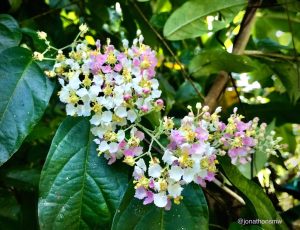 Tara yagé or Sëño yagé, the “bone” or “Yellow” variety. of yagé
Tara yagé or Sëño yagé, the “bone” or “Yellow” variety. of yagé
As for different types of yagé, there are well over a dozen distinct heirloom, or legacy, varieties. Among these, tara’yagé is most appreciated for it is considered to be the strongest variety. When it is prepared well, the variety allows for the yagé tú’tú, the “strength of the yagé,” to last all night long, remaining highly vibrant. Even more so when wai’yagé is added in (pronounced ‘why’ yagé). This being a pygmy yagé that is a rare endemic vine cultivated by the Western Tukanoan-speaking peoples of the Upper Amazon, which prolongs the effects of the yagé, making it much more potent. Wai’yagé, in many respects, is opposite of tara’yagé. While tara’yagé has long runner vines, wai’yagé is short; tara’yagé flowers and wai’yagé does not. With tara’yagé, the bone is used and the bark discarded, while with wai’yagé, only the bark is used and the inner bone discarded. Tara’yagé is grown away from the home in overgrown gardens where no one visits, and wai’yagé is always grown next to the house where the weeds and vegetation around it are kept cleared, and people are constantly present with their daily activities. Drinking yagé is about the harmonious uniting of opposites, for which reason, when these two come together, the brew rises to an entirely new level.
 Yagé ocó ~ Dipolpterys sp. possibly D. cabrerana or D longialata
Yagé ocó ~ Dipolpterys sp. possibly D. cabrerana or D longialata
 Chalipanga (Diplopterys sp.)
Chalipanga (Diplopterys sp.)
My personal experience has showed me, that these two vines together, when properly prepared; with the young leaves of the yagé ocó, the principal yagé admixture Diplopterys cabrerana, also a member of the Malpighiaceae family, the brew becomes extremely strong and powerfully visionary!
 Tara yagé or Sëño yagé, the “bone” or “Yellow” variety. of yagé
Tara yagé or Sëño yagé, the “bone” or “Yellow” variety. of yagé
Tara’yagé is also known as sëño yagé. In Paicoca, tara means ‘bone’, and sëño means ‘yellow’. Among the Kichwa people, the variety is called killu ayahuasca; killu means yellow.
 The yellowish tan color of Tara yagé brews and sunrise renewal tea as seen here is also why tara yagé is called sëño yagé, “yellow yagé”
The yellowish tan color of Tara yagé brews and sunrise renewal tea as seen here is also why tara yagé is called sëño yagé, “yellow yagé”
This variety is the most preferred, being that the inebriation brought on by tara’yagé, when the brew is properly prepared, lasts for extended periods of time and as mentioned above, sustains the effects at a highly energetic level. Just as the stem of this variety runs long and uninterrupted, so do its effects, leaving drinkers with a high-pitched vibration in their bodies. It is referred to as yellow yagé given the yellowing leaves that are found in the canopy, and in general, the canopy of this vine has light green or lime green, almost yellowish color, unlike the other varieties that have prominently dark green leaves. Also, the yagé brew made with this vine retains a yellowish-tan to orange-brown color. This vine is also called joró yagé, meaning yagé that flowers, since this vine blooms profusely with the onset of the dry season. Tara’yagé has a generous canopy that can cover entire trees, unlike the other varieties of yagé that are less copious in this sense.
It is important to understand that there are different ways of interpreting the word ‘tara,’ which literally translates to “bone.” At the basic level, it implies that when the vine is cooked, all the bark is removed, leaving only the woody inner “bone” that is boiled to make yagé. With regard to tara’yagé, the bark literally slips off upon pounding so that what remains is the glistening inner bone. In traditional yagé brews, the bark has tannins that make one vomit; for this reason, it is pounded off. Prior to the ceremonies, a yagé leaf emetic is consumed in what is called tzí’tsó huajëye, the ‘sunrise renewal’ ceremony. Participants vomit copiously what Cesáreo would endearingly refer to as “snakehead soup.” This is necessary since it helps to hold in the yagé’repá (properly prepared yagé brew), thereby allowing celestial visions and spiritual learning to occur.
Additionally, tara’yagé has the peculiar trait of cleansing and enhancing bone marrow, consequently contributing to blood purification. For the Siekopai, brews cooked with tara’yagé can be felt in the bones, whereby a deep chill enters the bones during nights of yagé. It is believed that tara’yagé nourishes and strengthens the inner bone; thus strengthening the drinker at a core level. For this reason, the Siekopai maintain that the name tara’yagé implies that this plant helps one live an “upright”, ethical and integral life.
Jëasaipë yagé, a type of tara’yagé considered a celestial variety, was a gift to the yagé drinkers of the not-so-distant-past from divine immortals. The name of this yagé refers to the turquoise cotinga, a bird with iridescent blue feathers (a color that represents heaven). The chest feather of this bird is used to adorn the bands of Siekopai decorative head crowns. There is another variety called tiwa’kurú yagé, also known as ocó yagé and nea yagé that was obtained by a Siona yagé drinker from divine immortals inside the realms of the water and is named after the nunbird (Monasa nigrifrons), known in Paicoca as tiwa’kurú. It has long, running vines, similar to tara’yagé, but with far fewer leaves.
THE CANOPY OF THIS VINE IS SPARSE. THIS VARIETY HAS LEAVES THAT ARE A DARK GREEN COLOR, WITH UNDULATING BORDERS, SIMILAR TO THE WAVELIKE PATTERN OF WATER, WHICH IS WHY THE VARIETY IS ALSO KNOWN AS OCÓ YAGÉ, WHICH MEANS “WATER YAGÉ.”
When cooked, it produces a dark-colored yagé, which is why it is also referred to by the name nea yagé, or “black yagé.” The same variety has three names
 Wai’yagé the pygmy variety
Wai’yagé the pygmy variety
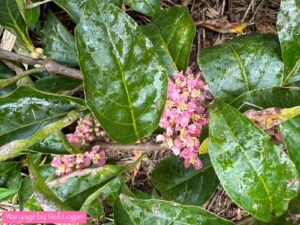
Wai’yagé is the variety given to the yagé drinkers by the Yeja wëwë’pai, the “immortals inside the earth.” It is a pygmy variety that, at most, grows only a few meters tall. Unlike the tara’yagé that is always grown at a distance from the house where few people walk and is always left to grow unrestrained, the wai’yagé is cultivated next to the home. The plant grows fast and thick in the vicinity of people and human activity. If wai’yagé is planted at a distance from the home, it is sparse and stays small, which is viewed as the plant being unhappy and thus unlikely to share its essence. Wai means “meat,” “game”, or “fish” in Paicoca, but more than that, it refers to the energetic dimensional abodes of animals, in other words, the place where the chiefs of animals reside. Wai’yagé is, therefore, related to the source of abundance and is used to communicate with these chiefs, who then allow wildlife to emerge into the communal territory so that people may live well.
The preparation of wai’yagé differs from that of the other varieties of yagé in that only the bark is used, and the inner woody bone is discarded. When added to boiling yagé brew, the bark will be first heavily pounded. From wai’yagé, a cold-water infusion is made by pounding the bark for many hours, adding young leaves of the yagé ocó admixture. Both plants are pounded for about four hours and then left in the sun until, at sunset, the mixture is strained. This occurs while a regular pot of yagé is being cooked. First, the yagé’repá is drunk. Then, at midnight, a few brave participants drink a well blown on gourd, with about two full cups of the pounded wai’yagé cold water infusion, which has a clear golden yellow color.
EVEN ONE CUP OF WAI’YAGÉ, WILL SEND AN INEXPERIENCED DRINKER SCREAMING, VOMITING AND SHITTING AT THE VERY SAME TIME, THEN LEAVE THIS PERSON SHIVERING ON THE GROUND, BEGGING REPENTANCE FOR EACH AND EVERY WRONGDOING THAT THE DRINKER HAS COMMITTED.
Only an experienced drinker can hold in the wai’yagé, and for this individual, the wonders of the celestial realms as well as the magic of the holographic universe, all become wonderfully apparent. There is a variety of wai’yagé called nuitu yagé that has apparently been lost. It grows in ways similar to wai’yagé but is twice as tall and has a thicker stalk.
There is another variety of wai’yagé, called joya’yai yagé, or “dog yagé,” that has splotches of yellow coloration on its dark green leaves. This variety is prepared as a cold-water infusion, pounded much in the same way but not as long, perhaps 30 minutes. The liquid is then given to their dogs so that they may become good hunters. It is also worth mentioning in this vein that there is as well a yellow-splotched-leaf variety of Brugmansia, only for dogs, called joya’yai pejí.
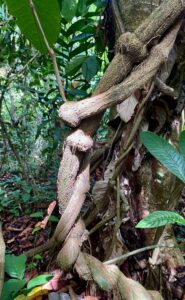 Tzinca yagé or Mukutulluhuasca the “swollen node” variety
Tzinca yagé or Mukutulluhuasca the “swollen node” variety

Tzinca’yagé (in Paicoca) or mukutulluhuasca (in the Kichwa Runashimi language) is the swollen-node variety of B. caapi. Its leaves are a darker, almost blue-green color, and they are considerably larger and wider than tara’yagé leaves. This vine doesn’t grow as tall and has a relatively sparse canopy. Interestingly, at the top of the branches of this variety, the leaves form thick clusters. Tzinca’yagé always flowers after the tara’yagé. This variety is perceived as not being as strong as tara’yagé: the swollen nodes cause the inebriation of yagé to rise and drop, rise and drop.
 Airo yagé a “rainforest” or “wild” yagé growing at the wilderness lakes of Pëe’kë’yá in the lower Ecuadorian Amazon.
Airo yagé a “rainforest” or “wild” yagé growing at the wilderness lakes of Pëe’kë’yá in the lower Ecuadorian Amazon.
Airo’yagé is a wild yagé, airo meaning “forest”. This variety resembles tara’yagé, but the bark, when pounded, doesn’t fall off easily as is the case with tara’yagé, which is one reason why it is rarely, if ever, drunk. In Rainforest Medicine, I share an experience I witnessed firsthand of a Siekopai man who harvested without permission and who was punished by the vine’s spiritual owner. Airo’yagé is also connected with atmospheric phenomena. I remember one occasion, at the wilderness lagoons of Pëe’kë’yá (Black-caiman lakes), on Ecuador’s border with Peru, the ancestral territory of the Siekopai people, when Don Delfin Payaguaje (Fernando’s son) and I walked past an airo’yagé vine.
WHEN I APPROACHED THE VINE TO TAKE A PHOTOGRAPH, DELFÍN ADVISED ME NOT TO GET TOO CLOSE. AS SOON AS I DREW NEAR THE VINE, A BOLT OF THUNDER EXPLODED DIRECTLY ABOVE US, AND THE CLEAR, SUNNY DAY TURNED ALMOST IMMEDIATELY INTO A TORRENTIAL DOWNPOUR.
Although there are many other varieties, I will leave the reader with these in the hopes that this information will be helpful in terms of safeguarding traditional wisdom in addition to the well-being of indigenous peoples and their rainforest homes.

This article was originally published at www.microcosmssacredplants.org and at https://kahpi.net
